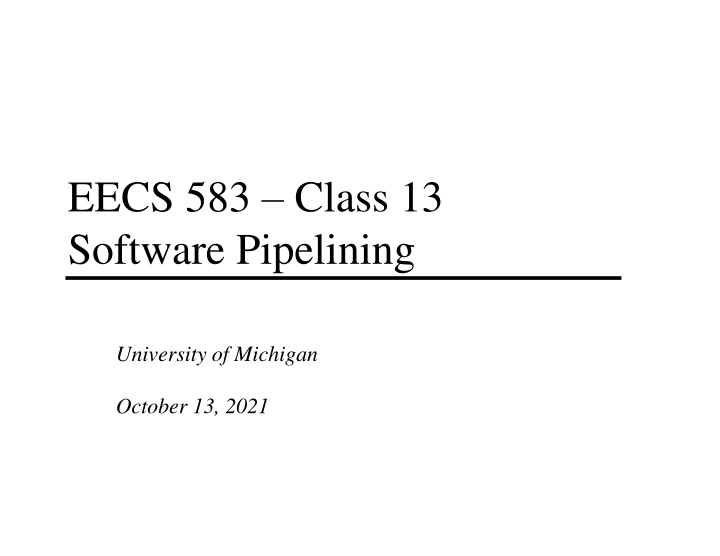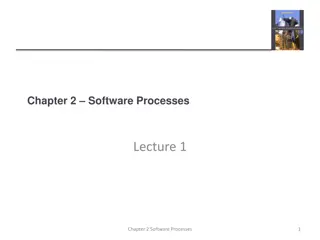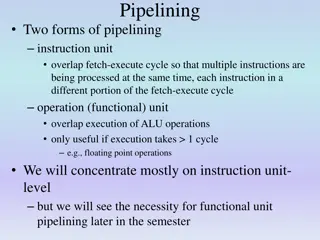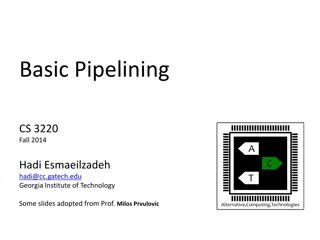Software Pipelining at University: Terminology and Resource Usage
Dive into the world of software pipelining with a focus on initiation interval and resource usage legality. Understand the terminologies like Initiation Interval (II) and Stage Count (SC), and learn about the importance of ensuring resource usage legality in software pipelining. Explore the concepts of resource constraints and dependences in a loop, enabling efficient software pipelining strategies for enhanced performance. Get ready to optimize your software pipelines with these key insights.
Download Presentation

Please find below an Image/Link to download the presentation.
The content on the website is provided AS IS for your information and personal use only. It may not be sold, licensed, or shared on other websites without obtaining consent from the author.If you encounter any issues during the download, it is possible that the publisher has removed the file from their server.
You are allowed to download the files provided on this website for personal or commercial use, subject to the condition that they are used lawfully. All files are the property of their respective owners.
The content on the website is provided AS IS for your information and personal use only. It may not be sold, licensed, or shared on other websites without obtaining consent from the author.
E N D
Presentation Transcript
EECS 583 Class 13 Software Pipelining University of Michigan October 13, 2021
Announcements + Reading Material Project discussion meetings next week (Wed/Thu/Fri) + Monday Oct 25 (Wed Oct 27 is next regular class) Each group meets 10 mins with Yunjie/Ze and I Action item Need to identify group members Use piazza to recruit additional group members or express your availability Think about project areas that you want to work on Google calendar signup available see piazza Project proposals Due Wednesday, Oct 27, 11:59pm 1 paragraph summary of what you plan to work on Topic, what are you going to do, what is the goal, 1-2 references Email to me & Yunjie & Ze, cc all your group members Today s class reading Iterative Modulo Scheduling: An Algorithm for Software Pipelining Loops , B. Rau, MICRO-27, 1994, pp. 63-74. Code Generation Schema for Modulo Scheduled Loops , B. Rau, M. Schlansker, and P. Tirumalai, MICRO-25, Dec. 1992. - 1 -
Software Pipelining Terminology Initiation Interval (II) = fixed delay between the start of successive iterations time Each iteration can be divided into stages consisting of II cycles each Iter 3 II Iter 2 Number of stages in 1 iteration is termed the stage count (SC) Iter 1 Takes SC-1 cycles to fill/drain the pipe - 2 -
Resource Usage Legality Need to guarantee that No resource is used at 2 points in time that are separated by an interval which is a multiple of II I.E., within a single iteration, the same resource is never used more than 1x at the same time modulo II Known as modulo constraint, where the name modulo scheduling comes from Modulo reservation table solves this problem To schedule an op at time T needing resource R The entry for R at T mod II must be free Mark busy at T mod II if schedule br alu1 alu2 mem bus0 bus1 0 II = 3 1 2 - 3 -
Dependences in a Loop Need worry about 2 kinds Intra-iteration Inter-iteration Delay Minimum time interval between the start of operations Operation read/write times Distance Number of iterations separating the 2 operations involved Distance of 0 means intra- iteration Recurrence manifests itself as a circuit in the dependence graph 1 <1,1> <1,2> 2 <1,2> <1,0> 3 <1,0> 4 Edges annotated with tuple <delay, distance> - 4 -
Dynamic Single Assignment (DSA) Form Impossible to overlap iterations because each iteration writes to the same register. So, we ll have to remove the anti and output dependences. Virtual rotating registers * Each register is an infinite push down array (Expanded virtual reg or EVR) * Write to top element, but can reference any element * Remap operation slides everything down r[n] changes to r[n+1] A program is in DSA form if the same virtual register (EVR element) is never assigned to more than 1x on any dynamic execution path 1: r3[-1] = load(r1[0]) 2: r4[-1] = r3[-1] * 26 3: store (r2[0], r4[-1]) 4: r1[-1] = r1[0] + 4 5: r2[-1] = r2[0] + 4 6: p1[-1] = cmpp (r1[-1] < r9) remap r1, r2, r3, r4, p1 7: brct p1[-1] Loop 1: r3 = load(r1) 2: r4 = r3 * 26 3: store (r2, r4) 4: r1 = r1 + 4 5: r2 = r2 + 4 6: p1 = cmpp (r1 < r9) 7: brct p1 Loop DSA conversion - 5 -
Physical Realization of EVRs EVR may contain an unlimited number values But, only a finite contiguous set of elements of an EVR are ever live at any point in time These must be given physical registers Conventional register file Remaps are essentially copies, so each EVR is realized by a set of physical registers and copies are inserted Rotating registers Direct support for EVRs No copies needed File rotated after each loop iteration is completed - 6 -
Loop Dependence Example 1,1 1 2,0 1: r3[-1] = load(r1[0]) 2: r4[-1] = r3[-1] * 26 3: store (r2[0], r4[-1]) 4: r1[-1] = r1[0] + 4 5: r2[-1] = r2[0] + 4 6: p1[-1] = cmpp (r1[-1] < r9) remap r1, r2, r3, r4, p1 7: brct p1[-1] Loop 2 0,0 3,0 3 0,0 1,1 1,1 4 1,0 1,1 5 6 In DSA form, there are no inter-iteration anti or output dependences! 1,0 7 <delay, distance> - 7 -
Class Problem Latencies: ld = 2, st = 1, add = 1, cmpp = 1, br = 1 1 1: r1[-1] = load(r2[0]) 2: r3[-1] = r1[1] r1[2] 3: store (r3[-1], r2[0]) 4: r2[-1] = r2[0] + 4 5: p1[-1] = cmpp (r2[-1] < 100) remap r1, r2, r3 6: brct p1[-1] Loop 2 3 4 5 Draw the dependence graph showing both intra and inter iteration dependences 6 - 8 -
Minimum Initiation Interval (MII) Remember, II = number of cycles between the start of successive iterations Modulo scheduling requires a candidate II be selected before scheduling is attempted Try candidate II, see if it works If not, increase by 1, try again repeating until successful MII is a lower bound on the II MII = Max(ResMII, RecMII) ResMII = resource constrained MII Resource usage requirements of 1 iteration RecMII = recurrence constrained MII Latency of the circuits in the dependence graph - 9 -
ResMII Concept: If there were no dependences between the operations, what is the the shortest possible schedule? Simple resource model A processor has a set of resources R. For each resource r in R there is count(r) specifying the number of identical copies ResMII = MAX (uses(r) / count(r)) for all r in R uses(r) = number of times the resource is used in 1 iteration In reality its more complex than this because operations can have multiple alternatives (different choices for resources it could be assigned to), but we will ignore this for now - 10 -
ResMII Example ResMII = MAX (uses(r) / count(r)) resources: 4 issue, 2 alu, 1 mem, 1 br latencies: add=1, mpy=3, ld = 2, st = 1, br = 1 uses(r) = number of times the resource is used in 1 iteration 1: r3 = load(r1) 2: r4 = r3 * 26 3: store (r2, r4) 4: r1 = r1 + 4 5: r2 = r2 + 4 6: p1 = cmpp (r1 < r9) 7: brct p1 Loop ALU: used by 2, 4, 5, 6 4 ops / 2 units = 2 Mem: used by 1, 3 2 ops / 1 unit = 2 Br: used by 7 1 op / 1 unit = 1 ResMII = MAX(2,2,1) = 2 - 11 -
RecMII Approach: Enumerate all irredundant elementary circuits in the dependence graph RecMII = MAX (delay(c) / distance(c)) for all c in C delay(c) = total latency in dependence cycle c (sum of delays) distance(c) = total iteration distance of cycle c (sum of distances) cycle k k+1 k+2 k+3 k+4 k+5 1 2 1 1 3,1 4 cycles, RecMII = 4 3 1,0 2 1 2 delay(c) = 1 + 3 = 4 distance(c) = 0 + 1 = 1 RecMII = 4/1 = 4 - 12 -
RecMII Example 1,1 1: r3 = load(r1) 2: r4 = r3 * 26 3: store (r2, r4) 4: r1 = r1 + 4 5: r2 = r2 + 4 6: p1 = cmpp (r1 < r9) 7: brct p1 Loop 4 4: 1 / 1 = 1 5 5: 1 / 1 = 1 4 1 4: 1 / 1 = 1 5 3 5: 1 / 1 = 1 1 2,0 2 0,0 3,0 3 RecMII = MAX(1,1,1,1) = 1 0,0 1,1 1,1 4 Then, RecMII = MAX(delay(c) / distance(c)) 1,0 1,1 MII = MAX(ResMII, RecMII) MII = MAX(2,1) = 2 5 delay(c) = total latency in dependence cycle c (sum of delays) distance(c) = total iteration distance of cycle c (sum of distances) 6 1,0 7 <delay, distance> - 13 -
Class Problem Latencies: ld = 2, st = 1, add = 1, cmpp = 1, br = 1 Resources: 1 ALU, 1 MEM, 1 BR 1 <2,2> <2,3> <0,0> 2 <1,1> 1: r1[-1] = load(r2[0]) 2: r3[-1] = r1[1] r1[2] 3: store (r3[-1], r2[0]) 4: r2[-1] = r2[0] + 4 5: p1[-1] = cmpp (r2[-1] < 100) remap r1, r2, r3 6: brct p1[-1] Loop <1,0> 3 <0,0> <1,1> 4 <1,1> <1,0> 5 <1,0> Calculate RecMII, ResMII, and MII 6 - 14 -
Modulo Scheduling Process Use list scheduling but we need a few twists II is predetermined starts at MII, then is incremented Cyclic dependences complicate matters Estart/Priority/etc. Consumer scheduled before producer is considered There is a window where something can be scheduled! Guarantee the repeating pattern 2 constraints enforced on the schedule Each iteration begin exactly II cycles after the previous one Each time an operation is scheduled in 1 iteration, it is tentatively scheduled in subsequent iterations at intervals of II MRT used for this - 15 -
Priority Function Height-based priority worked well for acyclic scheduling, makes sense that it will work for loops as well Acyclic: 0, if X has no successors Height(X) = MAX ((Height(Y) + Delay(X,Y)), otherwise for all Y = succ(X) Cyclic: 0, if X has no successors HeightR(X) = MAX ((HeightR(Y) + EffDelay(X,Y)), otherwise for all Y = succ(X) EffDelay(X,Y) = Delay(X,Y) II*Distance(X,Y) - 16 -
Calculating Height 1. Insert pseudo edges from all nodes to branch with latency = 0, distance = 0 (dotted edges) Compute II, For this example assume II = 2 HeightR(4) = 2. 3. 1 4. HeightR(3) = 0,0 3,0 2 0,0 2,2 2,0 3 0,0 5. HeightR(2) = 1,1 4 6. HeightR(1) - 17 -
Calculating Height Solution 1. 2. 3. Insert pseudo edges from all nodes to branch with latency = 0, distance = 0 (dotted edges) Compute II, For this example assume II = 2 HeightR(4) = H(4) + (1 II*1) (Assume H(4) is 0 since not calculated yet 0 + 1-2 = -1 0 (Always MAX answer with 0) 1 4. HeightR(3) = MAX(H(4) + 0 II*0 = 0 + 0 2*0 = 0, H(2) + 2 II*2 = 0 + 2 2*2 = -2) = 0 0,0 3,0 2 Assume H(2) is 0 since not calculated yet 0,0 2,2 2,0 3 5. HeightR(2) = MAX(H(4) + 0 II*0 = 0 + 0 2*0 = 0, H(3) + 2 II*0 = 0 + 2 2*0 = 2) = 2 0,0 1,1 4 6. HeightR(1) = MAX(H(4) + 0 II*0 = 0 + 0 2*0 = 0, H(2) + 3 II*0 = 2 + 3 2*0 = 5) = 5 Now recalculate the heights to see if anything changes since HeightR(3) assumed wrong value for node 2 HeightR(3) = MAX(H(4) + 0 II*0 = 0 + 0 2*0 = 0, H(2) + 2 II*2 = 2 + 2 2*2 = 0) = 0 Unchanged, so no need to compute any other heights again 7. - 18 -
The Scheduling Window With cyclic scheduling, not all the predecessors may be scheduled, so a more flexible earliest schedule time is: 0, if X is not scheduled E(Y) = MAX MAX (0, SchedTime(X) + EffDelay(X,Y)), for all X = pred(Y) otherwise where EffDelay(X,Y) = Delay(X,Y) II*Distance(X,Y) Every II cycles a new loop iteration will be initialized, thus every II cycles the pattern will repeat. Thus, you only have to look in a window of size II, if the operation cannot be scheduled there, then it cannot be scheduled. Latest schedule time(Y) = L(Y) = E(Y) + II 1 - 19 -
Loop Prolog and Epilog II = 3 Prolog Kernel Epilog Only the kernel involves executing full width of operations Prolog and epilog execute a subset (ramp-up and ramp-down) - 20 -
Separate Code for Prolog and Epilog Prolog - fill the pipe A0 A1 B0 A2 B1 C0 A B C D Loop body with 4 ops A B C D Bn Cn-1 Dn-2 Cn Dn-1 Dn Kernel Epilog - drain the pipe Generate special code before the loop (preheader) to fill the pipe and special code after the loop to drain the pipe. Peel off II-1 iterations for the prolog. Complete II-1 iterations in epilog - 21 -
Removing Prolog/Epilog II = 3 Prolog Kernel Disable using predicated execution Epilog Execute loop kernel on every iteration, but for prolog and epilog selectively disable the appropriate operations to fill/drain the pipeline - 22 -
Kernel-only Code Using Rotating Predicates A0 A1 B0 A2 B1 C0 A if P[0] B if P[1] C if P[2] D if P[3] A B C D Bn Cn-1 Dn-2 Cn Dn-1 Dn P referred to as the staging predicate P[0] 1 1 1 1 0 0 0 P[1] 0 1 1 1 P[2] 0 0 1 1 P[3] 0 0 0 1 A A A A - - - - B B B - - C C - - - D 1 0 0 1 1 0 1 1 1 B - - C C - D D D - 23 -
Modulo Scheduling Architectural Support Loop requiring N iterations Will take N + (S 1) where S is the number of stages 2 special registers created LC: loop counter (holds N) ESC: epilog stage counter (holds S) Software pipeline branch operations Initialize LC = N, ESC = S in loop preheader All rotating predicates are cleared SWP-BR (BRF) While LC > 0, decrement LC and RRB, P[0] = 1, branch to top of loop This occurs for prolog and kernel If LC = 0, then while ESC > 0, decrement RRB and write a 0 into P[0], and branch to the top of the loop This occurs for the epilog - 24 -
Execution History With LC/ESC LC = 3, ESC = 3 /* Remember 0 relative!! */ Clear all rotating predicates P[0] = 1 A if P[0]; B if P[1]; C if P[2]; D if P[3]; P[0] = BRF; LC 3 2 1 0 0 0 0 ESC 3 3 3 3 2 1 0 P[0] 1 1 1 1 0 0 0 P[1] 0 1 1 1 1 0 0 P[2] 0 0 1 1 1 1 0 P[3] 0 0 0 1 1 1 1 A A A A - - - B B B B - - C C C C - D D D D 4 iterations, 4 stages, II = 1, Note 4 + 4 1 iterations of kernel executed - 25 -
Homework Go through the following example We ll go through it in class after Fall Break and project meetings - 26 -
Modulo Scheduling Example resources: 4 issue, 2 alu, 1 mem, 1 br latencies: add=1, mpy=3, ld = 2, st = 1, br = 1 Step1: Compute to loop into form that uses LC for (j=0; j<100; j++) b[j] = a[j] * 26 LC = 99 Loop: 1: r3 = load(r1) 2: r4 = r3 * 26 3: store (r2, r4) 4: r1 = r1 + 4 5: r2 = r2 + 4 7: brlc Loop Loop: 1: r3 = load(r1) 2: r4 = r3 * 26 3: store (r2, r4) 4: r1 = r1 + 4 5: r2 = r2 + 4 6: p1 = cmpp (r1 < r9) 7: brct p1 Loop - 27 -
Example Step 2 resources: 4 issue, 2 alu, 1 mem, 1 br latencies: add=1, mpy=3, ld = 2, st = 1, br = 1 Step 2: DSA convert LC = 99 LC = 99 Loop: 1: r3 = load(r1) 2: r4 = r3 * 26 3: store (r2, r4) 4: r1 = r1 + 4 5: r2 = r2 + 4 7: brlc Loop Loop: 1: r3[-1] = load(r1[0]) 2: r4[-1] = r3[-1] * 26 3: store (r2[0], r4[-1]) 4: r1[-1] = r1[0] + 4 5: r2[-1] = r2[0] + 4 remap r1, r2, r3, r4 7: brlc Loop - 28 -
Example Step 3 Step3: Draw dependence graph Calculate MII resources: 4 issue, 2 alu, 1 mem, 1 br latencies: add=1, mpy=3, ld = 2, st = 1, br = 1 1,1 1 2,0 LC = 99 0,0 2 Loop: 1: r3[-1] = load(r1[0]) 2: r4[-1] = r3[-1] * 26 3: store (r2[0], r4[-1]) 4: r1[-1] = r1[0] + 4 5: r2[-1] = r2[0] + 4 remap r1, r2, r3, r4 7: brlc Loop 3,0 3 RecMII = 1 RESMII = 2 MII = 2 1,1 1,1 4 0,0 1,1 5 1,1 7 - 29 -
Example Step 4 Step 4 Calculate priorities (MAX height to pseudo stop node) 1,1 0,0 1 Iter1 Iter2 2,0 0,0 1: H = 5 2: H = 3 3: H = 0 4: H = 0 5: H = 0 7: H = 0 1: H = 5 2: H = 3 3: H = 0 4: H = 4 5: H = 0 7: H = 0 2 0,0 3,0 3 0,0 1,1 1,1 0,0 4 0,0 1,1 5 0,0 1,1 7 - 30 -
Example Step 5 resources: 4 issue, 2 alu, 1 mem, 1 br latencies: add=1, mpy=3, ld = 2, st = 1, br = 1 Schedule brlc at time II - 1 Unrolled Schedule Rolled Schedule LC = 99 0 1 2 3 4 5 6 Loop: 1: r3[-1] = load(r1[0]) 2: r4[-1] = r3[-1] * 26 3: store (r2[0], r4[-1]) 4: r1[-1] = r1[0] + 4 5: r2[-1] = r2[0] + 4 remap r1, r2, r3, r4 7: brlc Loop 0 1 7 mem br alu1 alu0 0 MRT 1 X - 31 -
Example Step 6 Step6: Schedule the highest priority op Op1: E = 0, L = 1 Place at time 0 (0 % 2) Unrolled Schedule Rolled Schedule LC = 99 1 0 1 2 3 4 5 6 Loop: 1: r3[-1] = load(r1[0]) 2: r4[-1] = r3[-1] * 26 3: store (r2[0], r4[-1]) 4: r1[-1] = r1[0] + 4 5: r2[-1] = r2[0] + 4 remap r1, r2, r3, r4 7: brlc Loop 1 0 1 7 mem br alu1 alu0 X 0 MRT 1 X - 32 -
Example Step 7 Step7: Schedule the highest priority op Op4: E = 0, L = 1 Place at time 0 (0 % 2) Unrolled Schedule Rolled Schedule LC = 99 1 0 1 2 3 4 5 6 4 Loop: 1: r3[-1] = load(r1[0]) 2: r4[-1] = r3[-1] * 26 3: store (r2[0], r4[-1]) 4: r1[-1] = r1[0] + 4 5: r2[-1] = r2[0] + 4 remap r1, r2, r3, r4 7: brlc Loop 1 4 0 1 7 mem br alu1 alu0 X X 0 MRT 1 X - 33 -
Example Step 8 Step8: Schedule the highest priority op Op2: E = 2, L = 3 Place at time 2 (2 % 2) Unrolled Schedule Rolled Schedule LC = 99 1 0 1 2 3 4 5 6 4 Loop: 1: r3[-1] = load(r1[0]) 2: r4[-1] = r3[-1] * 26 3: store (r2[0], r4[-1]) 4: r1[-1] = r1[0] + 4 5: r2[-1] = r2[0] + 4 remap r1, r2, r3, r4 7: brlc Loop 2 1 4 2 0 1 7 mem br alu1 alu0 X X X 0 MRT 1 X - 34 -
Example Step 9 Step9: Schedule the highest priority op Op3: E = 5, L = 6 Place at time 5 (5 % 2) Unrolled Schedule Rolled Schedule LC = 99 1 4 0 1 2 3 4 5 6 Loop: 1: r3[-1] = load(r1[0]) 2: r4[-1] = r3[-1] * 26 3: store (r2[0], r4[-1]) 4: r1[-1] = r1[0] + 4 5: r2[-1] = r2[0] + 4 remap r1, r2, r3, r4 7: brlc Loop 2 1 2 4 0 1 7 3 3 mem br alu1 alu0 X X X 0 MRT 1 X X - 35 -
Example Step 10 Step10: Schedule the highest priority op Op5: E = 5, L = 6 Place at time 5 (5 % 2) Unrolled Schedule Rolled Schedule LC = 99 1 4 0 1 2 3 4 5 6 Loop: 1: r3[-1] = load(r1[0]) 2: r4[-1] = r3[-1] * 26 3: store (r2[0], r4[-1]) 4: r1[-1] = r1[0] + 4 5: r2[-1] = r2[0] + 4 remap r1, r2, r3, r4 7: brlc Loop 2 1 2 4 0 1 7 3 5 5 3 mem br alu1 alu0 X X X 0 MRT 1 X X X - 36 -
Example Step 11 Step11: calculate ESC, SC = ceiling(max unrolled sched length / ii) unrolled sched time of branch = rolled sched time of br + (ii*esc) SC = 6 / 2 = 3, ESC = SC 1 time of br = 1 + 2*2 = 5 Unrolled Schedule Rolled Schedule LC = 99 1 4 0 1 2 3 4 5 6 Loop: 1: r3[-1] = load(r1[0]) 2: r4[-1] = r3[-1] * 26 3: store (r2[0], r4[-1]) 4: r1[-1] = r1[0] + 4 5: r2[-1] = r2[0] + 4 remap r1, r2, r3, r4 7: brlc Loop 2 1 2 4 0 1 7 3 5 5 3 7 mem br alu1 alu0 X X X 0 MRT 1 X X X - 37 -
Example Step 12 Finishing touches - Sort ops, initialize ESC, insert BRF and staging predicate, initialize staging predicate outside loop Staging predicate, each successive stage increment the index of the staging predicate by 1, stage 1 gets px[0] LC = 99 ESC = 2 p1[0] = 1 Loop: 1: r3[-1] = load(r1[0]) if p1[0] 2: r4[-1] = r3[-1] * 26 if p1[1] 4: r1[-1] = r1[0] + 4 if p1[0] 3: store (r2[0], r4[-1]) if p1[2] 5: r2[-1] = r2[0] + 4 if p1[2] 7: brlc Loop if p1[2] Unrolled Schedule 1 4 0 1 2 3 4 5 6 Stage 1 2 Stage 2 Stage 3 3 5 7 - 38 -
Example Dynamic Execution of the Code time: ops executed LC = 99 ESC = 2 p1[0] = 1 0: 1, 4 1: 2: 1,2,4 3: 4: 1,2,4 5: 3,5,7 6: 1,2,4 7: 3,5,7 198: 1,2,4 199: 3,5,7 200: 2 201: 3,5,7 202: - 203 3,5,7 Loop: 1: r3[-1] = load(r1[0]) if p1[0] 2: r4[-1] = r3[-1] * 26 if p1[1] 4: r1[-1] = r1[0] + 4 if p1[0] 3: store (r2[0], r4[-1]) if p1[2] 5: r2[-1] = r2[0] + 4 if p1[2] 7: brlc Loop if p1[2] Total time = II(num_iteration + num_stages 1) = 2(100 + 3 1) = 204 cycles - 39 -























